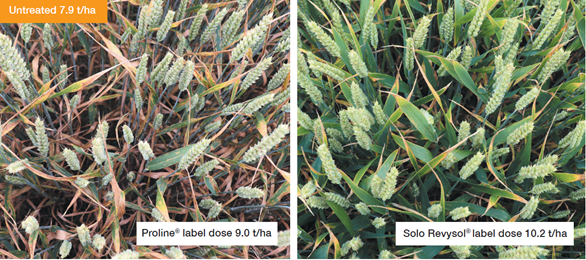Revysol (mefentrifluconazole), is the most curative and persistent fungicide available to the market for cereal disease control, and one that is ideally suited to difficult Irish weather, with strong performance on key diseases in both wheat and barley.
Dr. Tom McCabe, agronomy specialist at University College Dublin (UCD) said: “Revysol is a welcome and exciting introduction into the fungicide market. It is the first azole fungicide introduced in fifteen years and that has been extremely important and welcome.
“Revysol certainly gives farmers better options for disease control, particularly for septoria in winter wheat.
“Although 2020 was regarded as a low disease pressure year, we had a number of trials in high pressure septoria sites in the south of the country, in north Cork and south Tipperary,” he continued.
“Here we saw really good performance from Revysol, with high levels of disease control and very good grain yield response.
“In our trials, Revysol was the most curative product and when the rates are kept robust, you are looking at excellent persistence too. We saw this efficacy across all the varieties we used, which have a range of resistance to septoria.”
Why does Revysol work so well?
Dr. Rosie Bryson, European head of technical project management, BASF, said: “Revysol has a unique property, a ‘hook’ which gives the molecule flexibility.
“Revysol binds to fungal target sites 100 times more powerfully than conventional azoles, resulting in stronger efficacy, even on septoria populations changed by mutations.
“Septoria mutations generally have the biggest impact on control of this disease. Each mutation changes the shape of the target site and so makes it more difficult for the fungicide molecule to bind.
“The good news is that because of Revysol’s unique structure, quite different to conventional azole molecules, it can control all the existing strains of septoria.”

Resilient control
Increasingly variable weather means that growers need a product that can be relied on under all conditions. Cold temperatures during application are known to limit the uptake of conventional azoles and compromise their performance, however, Revysol performs well even in cool conditions.
Steve Dennis, BASF head of business development, UK and Ireland said:
“Revysol-containing products are formulated for fast foliar uptake, giving farmers greater confidence if weather deteriorates after application, effectively giving them a broader window of application as they can spray in ‘catchy’ conditions.
“Revysol’s quick uptake, in just 15 minutes, leads to rainfastness, protection from UV light degradation, and immediate and strong curative action.
“Once inside the leaf, Revysol forms reservoirs, allowing slow but consistent distribution of fungicide along the leaf length, which helps with long-term protection.”

Recommendations for winter wheat
David Leahy, business development manager, BASF said: “In winter wheat, we recommend Revysol based options at T1 and T2, to achieve the highest levels of septoria control.
“Revysol is the most curative fungicide on the market, and this year, due to the demise of chlorothalonil, there will be greater emphasis on product selection at T1.
“Lentyma is our primary option at T1. Containing both Revysol and Xemium, Lentyma combines excellent curative septoria activity, with eyepost and yellow rust control.
“Revystar XL is the most reliable product available at T2. It combines a high level of curative activity, with prolonged persistence through to harvest.”

Recommendations on barley
When it comes to managing disease in barley, in the absence of cholorothalonil, one eye will have to be on controlling ramularia.
Both Revysol products, Lentyma and Revystar XL can contribute to the control of ramularia.
David added: “The Revysol loading in each, offers an advantage over most alternative products when it comes to ramularia control, and Xemium helps deliver comprehensive, broad-spectrum disease-control and a reduction in brackling.”

Safeguarding Revysol ®
For growers, the strongest line of defence will always be to use a combination of the best tools available. Revysol continues to be an excellent resistance management partner to SDHIs (succinate dehydrogenase inhibitors) and other modes of action.
Combinations of Revysol mixed with Xemium, BASF’s best-in-class SDHI, are synergistic, giving a greater level of control than you’d expect from their individual components. Dr. McCabe said:
“The more modes of action you combine together, the better the long-term outcome will be for resistance management. Using contact fungicides will continue to be an important part of that.”
David Leahy added: “The inclusion of a multisite, like folpet, may improve overall disease control, particularly in high pressure situations.
“Along with an effective fungicide strategy, a combination of cultural control measures such as choosing a resistant variety and delayed drilling, should be adopted as part of an integrated pest management (IPM) strategy to successfully control disease.”
This season
Crops have come out of the winter much fuller and lush; plant counts are good; wheat crops are looking very well. Leahy added:
“When you have full crops, you are going to have disease, as rain is never far away. Everything is pointing to a high septoria pressure year and crops have potential, so that should be looked after by using the best chemistry available – Revysol.”
You can find out more about Revysol here.
Revystar XL, Lentyma, Xemium and Revysol are registered Trademarks of BASF. Lentyma and Revystar XL contain mefentrifluconazole and fluxapyroxad.
Further information at www.basf.com.

